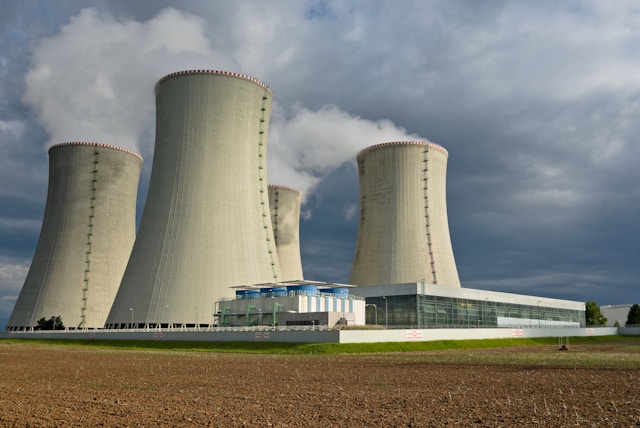Alberta’s Nuclear Future

As Alberta faces the dual challenge of reducing carbon emissions and meeting rising energy demands, the province is considering an ambitious, forward-thinking solution that promises a low-carbon future with reliable, round-the-clock energy: nuclear power.
Energy Alberta, a Calgary-based company, has unveiled a proposal to build a large-scale nuclear power plant in Alberta’s Peace Region. If approved, this project would include two Candu reactors, with the potential to expand to as many as five, producing up to 4,800 megawatts of power. For perspective, that’s nearly four times the output of Alberta’s largest natural gas-fired power station.
This proposal isn’t Alberta’s first flirtation with nuclear energy — Energy Alberta initially explored this idea in 2009, and though the project was shelved at the time, they’re back with renewed focus and updated technology. The question now isn’t just whether Alberta can support nuclear power, but whether nuclear is the right next step in Alberta’s energy evolution.
Is Nuclear A Clean, Reliable Power Source for Alberta’s Future
Nuclear power, unlike traditional fossil fuels, emits no carbon during operation, making it a strong contender for Alberta’s clean energy future. With advances in reactor technology, today’s nuclear plants are designed for long-term safety and stability. The reactors Energy Alberta proposes have lifespans of 60 to 70 years, meaning that they’re built to last and provide a stable energy supply for decades.
This is particularly relevant for Alberta, which still relies heavily on natural gas for electricity. As Alberta continues its transition away from coal, natural gas remains a major player in the province’s power grid, but nuclear could help reduce the province’s carbon footprint more effectively and sustainably. Unlike solar or wind power, which depend on weather conditions, nuclear power can operate at full capacity 24/7, providing a steady “baseload” of energy that can back up renewable sources during times when sunlight and wind aren’t available.
The Candu Reactor: A Canadian Innovation for Alberta’s Needs
The Candu reactors Energy Alberta plans to use have a legacy in Canada. Developed here in the 1950s, Candu technology has been refined over the years and operates reliably at sites across Ontario and around the world. These reactors use natural uranium, which is abundant in neighboring Saskatchewan, avoiding the need for enriched uranium and supporting a streamlined fuel supply chain. Energy Alberta’s project plans to use an updated Candu model — the Monark reactor — a design that combines time-tested Candu reliability with modern engineering advancements.
While Candu technology is proven and safe, Alberta’s move toward nuclear isn’t just about producing electricity; it’s also a potential game-changer for Alberta’s economy. By investing in high-skilled jobs and supporting Alberta’s local fuel supply chains, nuclear energy offers a long-term economic boost to communities in the Peace Region. Reeve Terry Ungarian, a local leader, believes this project could be transformative, attracting skilled professionals to the region and building Alberta’s reputation as a leader in advanced energy solutions.
Addressing Nuclear Waste — The Long-Term Solution in Progress
One of the most common concerns surrounding nuclear energy is the question of waste. Nuclear fuel remains radioactive for thousands of years, requiring secure and thoughtful handling. Canada’s current approach involves storing spent fuel in specialized facilities designed to contain radioactive materials safely for decades. As technology progresses, so do strategies for dealing with waste — from advanced containment systems to deep geological repositories. The Nuclear Waste Management Organization (NWMO) is actively developing long-term storage solutions, providing oversight and ensuring Alberta’s waste is responsibly managed.
In fact, nuclear waste management has been successfully implemented in Ontario for decades without significant issues. While this is certainly a factor in any nuclear project, Alberta’s waste management plan would follow Canada’s well-established protocols, overseen by the Canadian Nuclear Safety Commission, to keep both workers and residents safe.
Financial Feasibility will likely be Private Investment, Public Gains
With a projected price tag around $35 billion, Energy Alberta’s nuclear proposal isn’t a small investment. However, it’s worth noting that this project will be funded entirely by private-sector capital. While the government will likely assist in facilitating agreements and providing guarantees to attract investors, no public funds are required, ensuring that Alberta taxpayers aren’t footing the bill. For a project that could potentially power nearly a third of Alberta’s homes, this is an exciting development — private investment, public benefit, and a cleaner, more reliable energy supply.
Of course, Energy Alberta is still working on final cost projections, and the company expects to solidify these figures in the coming years. Nuclear power is a long-term commitment, and Alberta’s decision will require careful planning and support from local communities. Yet, with a solid economic foundation and private funding secured, this project has the potential to be an innovative model for energy projects across Canada.
Public Opinion and the Nuclear Conversation
While opinions on nuclear energy are varied, public sentiment toward cleaner energy sources is overwhelmingly positive. According to recent polls, Albertans support a range of energy options, and while solar and wind lead the pack, interest in nuclear has been steadily growing. With the push for cleaner energy sources, nuclear could play a unique role in Alberta’s energy mix, complementing the province’s renewable projects while reducing emissions.
In Alberta’s last public consultation on nuclear power, 45 percent of respondents believed projects should be evaluated case-by-case. This sentiment shows that while nuclear energy may not be universally embraced, Albertans are open to considering it as part of a balanced energy portfolio.
Balancing Energy, Environment, and Economy
Energy Alberta’s proposal for a nuclear plant in the Peace Region is an innovative approach to meeting Alberta’s energy needs without increasing carbon emissions. Nuclear power offers Alberta a chance to achieve energy security, economic growth, and lower emissions all at once. It’s a bold solution that aligns with the province’s goals for a cleaner, reliable energy future.
Of course, this is a complex decision, and it’s important to weigh all aspects carefully. But Alberta’s commitment to exploring nuclear energy is a forward-thinking approach that could pave the way for other provinces. Nuclear power may not be a cure-all, but it’s a proven, low-carbon solution with the potential to provide Alberta with safe, clean, and consistent power for generations.
As Energy Alberta moves forward with its planning, it’s encouraging to see a diverse range of voices — from environmental advocates to community leaders — engaging in this dialogue. Alberta’s nuclear proposal presents an opportunity to take the lead in Canada’s evolving energy landscape, balancing progress with responsibility, and building a sustainable future for all Albertans.





